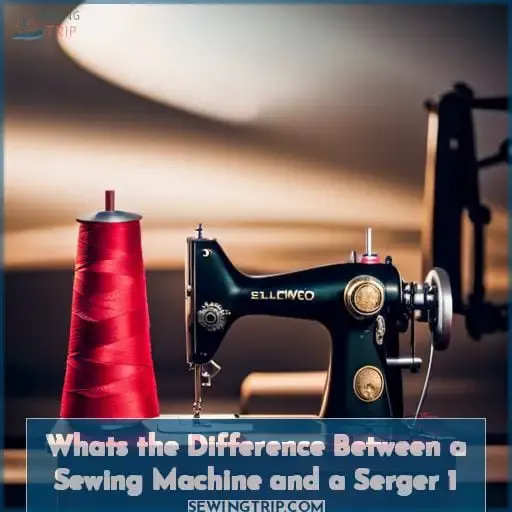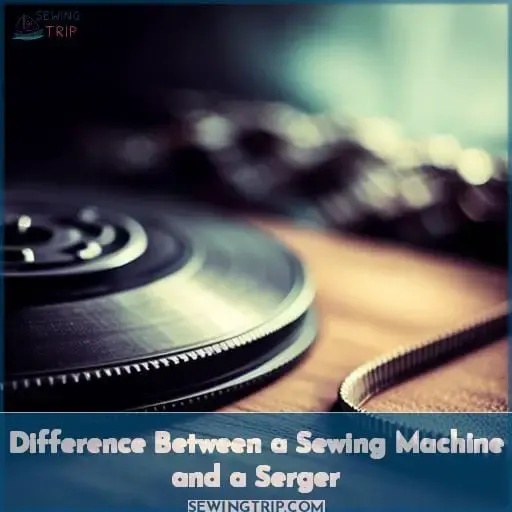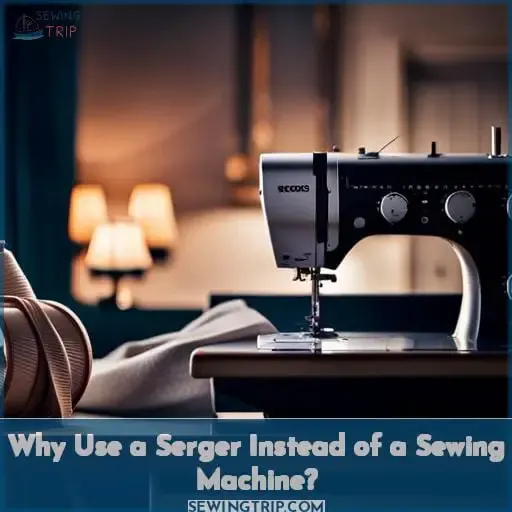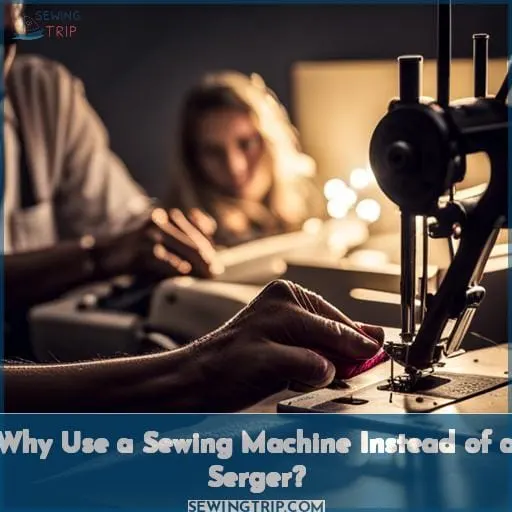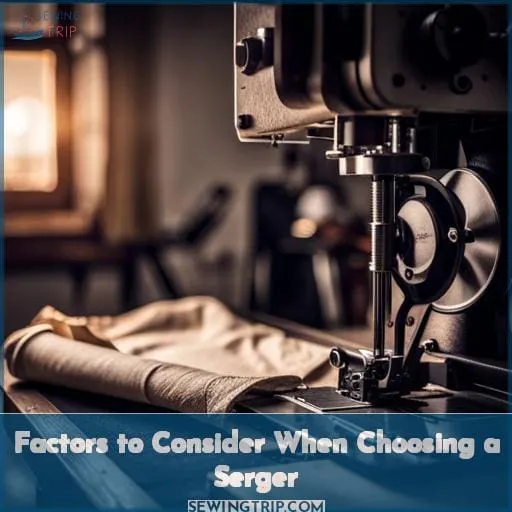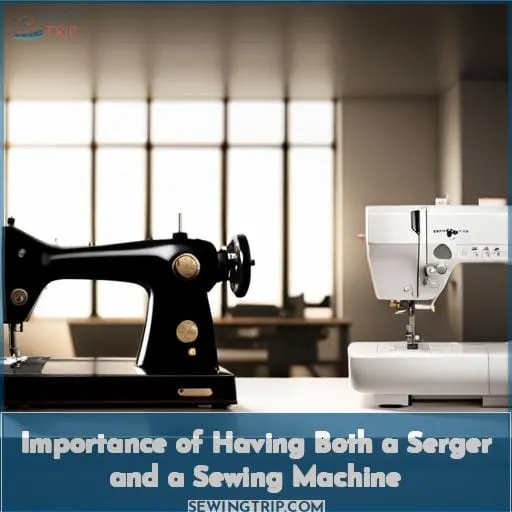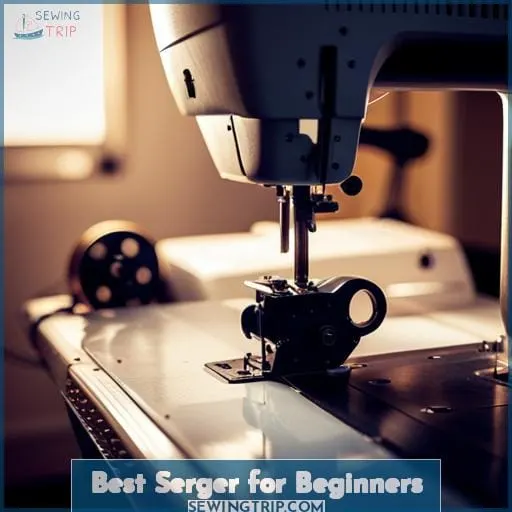This site is supported by our readers. We may earn a commission, at no cost to you, if you purchase through links.
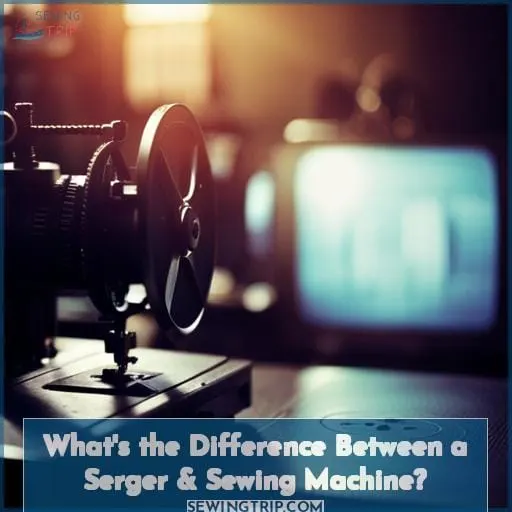
A serger, also known as an overlocker, is essentially just another type of sewing machine. It binds fabric together with an overlock stitch created by three or four threads. It can be used for finishing fabric edges or creating decorative stitches on stretchy fabrics that would otherwise be difficult to work with using traditional methods.
And while it has its uses in certain projects like making buttonholes and topstitching zippers, it’s not ideal for all tasks – sometimes the best results come from combining both machines into one project.
In this article, we’ll explore why having both types of machines is important along with key factors to consider when choosing your first serger.
Table Of Contents
- Key Takeaways
- Definition of a Serger
- Difference Between a Sewing Machine and a Serger
- Why Use a Serger Instead of a Sewing Machine?
- Why Use a Sewing Machine Instead of a Serger?
- Factors to Consider When Choosing a Serger
- Importance of Having Both a Serger and a Sewing Machine
- Best Serger for Beginners
- Frequently Asked Questions (FAQs)
- Conclusion
Key Takeaways
- Sergers are specialized sewing machines used for finishing fabric edges and creating decorative stitches on stretchy fabrics.
- Sergers have the ability to trim, stitch, and overcast fabric edges, making them ideal for working with knit or stretchy fabrics.
- Unlike regular sewing machines, sergers do not require bobbins and use loopers to create a locking stitch formation for superior strength.
- While sewing machines are essential for tasks like making buttonholes, topstitching, and attaching zippers, sergers can also perform these functions more efficiently and provide professional-looking results.
Definition of a Serger
You can create a professional finish on clothing and fabric projects quickly with an overlock machine, also known as a serger. It is a special type of sewing machine that trims, stitches, and overcasts fabric edges – the perfect option for working with knit or stretchy fabrics.
Unlike traditional sewing machines, which require you to cut your fabric before beginning your project, sergers have knives built in so you can cleanly trim away excess material while stitching. They usually come equipped with two or three needles, plus one looper threading each needle separately.
Sergers provide superior strength due to their locking stitch formation created by interlocking loopers. Plus, they are easier and quicker than normal machines because they don’t need bobbins! A double needle provides added versatility when it comes to hemming pants too.
If you’re looking into buying an industrial serger, there are several features worth considering. These include the number of threads required (3/4), threading ease (self-threading models!), retractable upper knife, and differential feed options.
Whether using at home or professionally, this type of sewing machine will give any project sharp finishes and secure seams, allowing creativity without limitations.
Difference Between a Sewing Machine and a Serger
Discover the unique capabilities of a serger and sewing machine to craft professional-looking projects with ease. A typical sewing machine uses one or two threads, while a common serger utilizes 3-4 threads, creating a stronger, more durable stitch.
The main difference between them is that the rotary blade on a serger cuts fabric as it stitches – saving time and preventing seams from puckering – whereas regular machines require you to cut before starting your project.
When choosing which type of machine best suits your needs, factors like threading ease (self-threading models!), tension system, number of threads required (3/4), features such as a retractable upper knife and differential feed should be considered for optimal use.
Why Use a Serger Instead of a Sewing Machine?
Are you looking for a way to quickly finish fabric edges, sew stretchy fabrics, or create decorative stitches? Then using a serger is the perfect solution! Sergers are specifically designed to make sewing projects quicker and more efficient by trimming, stitching, and overcasting fabric edges.
They provide a stronger and more durable stitch than regular sewing machines due to their use of 3-4 threads instead of one or two. With features like retractable upper knives and differential feed, it’s easy to see why many people choose sergers over traditional machines when crafting professional-looking garments.
Finishing Fabric Edges
With a serger, you can effortlessly finish fabric edges for professional-looking projects in no time. Overlocking techniques vary by fabric type and tension of the thread used. Make sure to use the right needle for your project and keep up with regular maintenance on your machine, as well as adjusting seam allowance settings.
Sewing Stretchy Fabric
Experience the ease of creating beautifully finished pieces with a serger when sewing stretchy fabrics. It effortlessly binds fabric together, providing a strong, durable stitch while threading ease and features like differential feed and a retractable knife make it user-friendly.
Unlike an ordinary sewing machine, which requires straight stitching on both the left and right sides of the needle, sergers only require one side – making them ideal for projects that call for long necks or working on right sides.
Creating Decorative Stitches
You can create decorative stitches with a serger quickly and easily, making it the perfect tool for embellishing all your sewing projects. Threading ease, budget-friendly options, and user-friendly features like a retractable knife and differential feed make this machine an ideal choice for any serging expert or novice sewer.
Check out our comprehensive lessons to learn how to use your new machine. We provide personal opinions as well as affiliate links so you can get started today!
No matter what project you have in mind, a serger offers more versatility than a regular sewing machine when it comes to creating decorative stitches.
Why Use a Sewing Machine Instead of a Serger?
Although a serger is great for finishing fabric edges, sewing stretchy fabrics, and creating decorative stitches quickly and efficiently, it cannot replace a regular sewing machine. Sewing machines are essential for tasks like making buttonholes, topstitching garments with precision, attaching zippers securely to fabric layers, or adding unique touches by creating decorative stitching.
Making Buttonholes
Take your sewing projects to the next level with a serger – it can make buttonholes faster than you ever imagined possible! Whether you’re following techniques for thread selection, fabric types, or tension control, a serger will eliminate unnecessary work and help ensure good quality results.
A common example of this is DIY project garments where many people choose to use a serger instead of investing in machine maintenance.
Topstitching
Make topstitching look professional and effortless with a serger – it’s the perfect tool to give your projects that polished finish! Pinning techniques, thread types, tension levels, fabric types, and cutting options are all important considerations when using this machine.
The main thing to remember is that unlike a regular sewing machine, which uses one or two threads, a serger requires three or four different threads for its overlock stitch.
Sewing Zippers
For a neat finish on your project, try using a serger for sewing zippers – it’s the perfect tool to achieve that professional look! Choose one with user-friendly threading ease and budget-friendly options.
Creating Decorative Stitching
Create unique, decorative stitching on your garments with a serger for professional results! Seamless hems, rolled edges, and decorative seams are easily achieved when using this specialized machine. Perfect for knit or stretch fabrics, the serger produces faster and more durable stitches than those of a traditional sewing machine.
Make sure to select one that’s user-friendly with adjustable settings to get the most out of it.
Factors to Consider When Choosing a Serger
When it comes to choosing a serger, there are several factors to take into consideration. Firstly, the number of threads is an important factor; having multiple thread options can really up your sewing game and make garments look more professional.
Secondly, you should pay attention to the tension system; this will determine how evenly stitches are formed.
Thirdly, stitch width and length adjustment should be looked at carefully as well – some machines offer adjustable settings for different types of fabrics.
Lastly, additional features like a retractable upper knife or differential feed could come in handy for specific projects, so choose one that meets your needs!
Number of Threads
Choosing the right serger for your needs means considering how many threads you need – from 3 to 8! Threading ease, tension dials, blade cutting, and user-friendliness are all important factors. Choose a budget-friendly model that gives you the features you need without compromising quality.
When selecting a serger, be sure to look at its stitch width and length settings, as well as other special features like retractable upper knives or differential feed.
Tension System
When selecting a serger, its tension system is an important factor to consider – make sure it’s user-friendly and makes adjustments quick and easy! Threading ease, budget-friendliness, retractable upper knife, or differential feed should all be taken into account.
Stitch Width and Length Adjustment
Adjust the stitch width and length of your serger to achieve that perfect finish on all projects. Look for a model with a user-friendly tension system, adjustable thread tensions, a retractable knife, and differential feed.
Additional Features
Look for a model with additional features: a user-friendly tension system, adjustable thread tensions, a retractable upper knife, and differential feed. Achieve a perfect finish on projects! Threading ease is essential; budget-friendly options exist.
The retractable knife helps prevent fabric stretching, while the differential feed produces quality stitches effortlessly.
Importance of Having Both a Serger and a Sewing Machine
Having both a serger and a sewing machine is essential for creating professional-looking garments with ease, so don’t limit yourself to just one! With the range of features available on various machines, you can achieve different stitch types that are suitable for all fabrics.
Advanced thread types allow you to create intricate patterns and designs, while adjustable tension settings provide consistent stitching quality throughout projects. The user experience also varies between machines – some have self-threading functions or retractable upper knives, making them easier to use than others.
Whether it’s topstitching or hemming pants, having access to multiple tools allows you greater control over your clothing pieces, as well as more creative freedom with your designs and fabric choices. Invest in the right combination of serger and sewing machine based on what type of project you’ll be working on most regularly.
Best Serger for Beginners
For those just starting out in the world of sewing, investing in a user-friendly and budget-friendly serger is key – you don’t want to break the bank while learning! To make sure you get it right the first time round, test threading your machine before buying, as some models have self-threading functions.
Make sure to look for budget options that can still handle different fabrics and stitch types.
When choosing any serger brand or model, consider factors such as the number of threads used, the tension system set up, and the ease of threading. It’s always best to try each machine so you know which one suits your needs best before committing financially.
And remember – having both a sewing machine and a serger will open up more possibilities when working on garments!
Frequently Asked Questions (FAQs)
What types of fabrics can be used with a serger?
A serger is perfect for sewing stretchy fabrics like jersey and spandex, as well as knits.
Are there any special accessories I need to use with a serger?
Generally, a serger requires threads and needles specifically designed for it. Additionally, additional accessories like tweezers or thread nets may be helpful when dealing with tangled threads.
What is the maximum stitch length and width of a serger?
The maximum stitch length and width of a serger can vary depending on the model. Generally, you can expect to be able to adjust it between two millimeters for narrow stitches up to five millimeters for wide ones.
With some models, you might even get an extra-wide seven-millimeter option! Explore your options with care – these settings will make all the difference in your projects’ look and feel.
How do I thread a serger?
Master your serger with ease! Threading can seem daunting, but don’t worry – you’ll be a pro in no time. Get ready to explore the power of serging and experience liberation from tedious fabric-finishing tasks.
How often should I clean and oil my serger?
Consistently cleaning and oiling your serger will ensure it works for years to come. Set a regular schedule, such as once or twice a month; be sure to use the right products – check your manual for instructions.
Conclusion
Ultimately, the choice between a serger and a sewing machine depends on the project. Sewing machines are typically used for larger projects that require a longer neck and the ability to sew on both the right and left side of the needle.
Sergers, on the other hand, are great for projects that require a clean, raw edge, such as hemming pants. They are also faster and easier to use than traditional sewing machines, making them ideal for quick projects.
To get the best of both worlds, it is important to have both a serger and a sewing machine for your sewing room. With the right accessories and knowledge, you can create beautiful and professional-looking projects with either machine.
From hems to zippers, the serger and the sewing machine both play an essential role in creating stunning garments.

